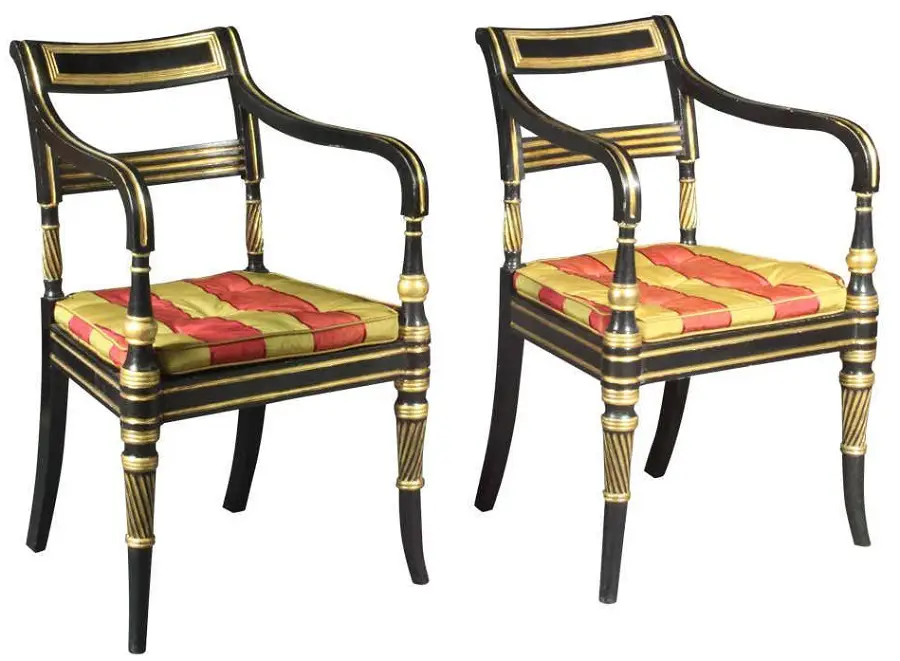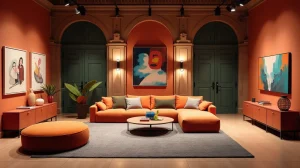Regency is a British style that is not just specific to furniture. It emerged and developed between 1795 and 1837, contemporaneous with Empire style with which it has many similarities, but also elements that set it apart. The Regency period was one of great cultural refinement and achievement in Britain, a period that touched the whole of society, influencing men's and women's fashion, architecture, the arts and not least, furniture. It had strong Roman, Greek and Egyptian influences, as did the Empire style, but also new elements brought in by personalities of the time such as Thomas Sheraton. The style had elegance and personality and remains attractive to this day. Let's see where the style's name Regency comes from and what its characteristics are.

Who was it that gave the name to the style
A style is usually named after the person who created or designed pieces of furniture that have stood the test of time, becoming reference models for enthusiasts. When there is no specific personality, such as Thomas Chippendale, for example, the name of the person who supported and influenced the style or the monarch of the period is adopted. Often they were one and the same person. This is also the case with the Regency style whose name comes from the period when King George IV ruled the United Kingdom as a replacement for his father King George III, who was still alive and suffering from mental illness. During that period (1811-1820) he was known as the Prince Regent, hence the name of the style.
George IV had a great influence on the style, encouraging artists and creators by commissioning works. He was a person who loved beauty and fun and was called the 'Prince of Pleasures'. He influenced the style through his passion for elements of Asian cultures, particularly Japanese and Chinese, which he incorporated into commissioned works. The influence of his personality continued after his death in 1830, and the style remained in vogue for almost another 10 years.
Regency influences and its defining elements
Unlike in earlier periods when the influence of classical styles was reflected in decorations and design that suggested this, in the Regency specific elements are copied. Admiration for Roman, Greek and Egyptian styles is so great that any archaeological finds inflame spirits and tend to be transposed into the works of the times. Furniture in museums or collections is copied and motifs such as ancient gods, sphinxes, lions or griffins are added. The Asian influence can be seen in the use of bamboo, wood imitating bamboo, ebonized furniture and polished, glossy lacquer. (Ebonizing is the transformation of furniture into ebony-looking furniture by staining a much less valuable wood black and lacquering it. A method much used in Japan.)
Despite all these influences, Regency furniture has elegance, straight and slender lines, avoiding curved shapes and surfaces. Chair legs are thin, often turned and finished with animal paws. The backrests are straight and upholstered or lower and ornamented with metal or wood. The symmetry of the Empire style is also present here. But the large pieces of furniture are smaller in size, they are shorter to leave room on the wall for paintings.
It is widely used mahogany wood and that of wagons and veneer from palisander, zebrano or mahogany. Brass and ormolu, an imitation of gold, cover the legs of chairs and tables, are used for lion's head handles on drawers or for the glass door grills of showcases. Inlaying, intarsia and lacquering with shellac and polishing by French polish.
In short, the main characteristics of the Regency style are:
- Shapes and motifs inspired by ancient Greek, Roman and Egyptian architecture and design.
- Clean and symmetrical profiles, whether straight lines or classic arches and geometric shapes.
- Motifs based on classic symbols - laurel wreaths, acanthus leaves, 'U' pound.
- Brass lion's heads to give a touch of regal pomp to your furniture. Ringed lion heads also serve as handles on drawers.
- Dark-colored wood that creates a majestic and stately feel. Mahogany was very popular with furniture makers. It kept its natural color and was varnished to give it a high sheen and highlight the grain.
- Use rosewood and zebrano veneers with inlays and inlays.
- Classic military motifs, blazons, swords and shields, brass decorations contrasting with the dark wood.
- The legs of the stool are straight or X-shaped, turned, columnar or sword-shaped. They end in paws, paws holding a ball or brass paws. And the ends of table legs are brass-plated. Showcases and bookcases are shorter leaving room on the wall for paintings or other art objects.
The Regency style has been much loved and unlike other styles, it has never disappeared but has adapted to modern elements. It is still sought after and appreciated, the old by collectors and the new by admirers of a romantic world, the world of Jane Austen and Mr. Darcy.



































Add comment